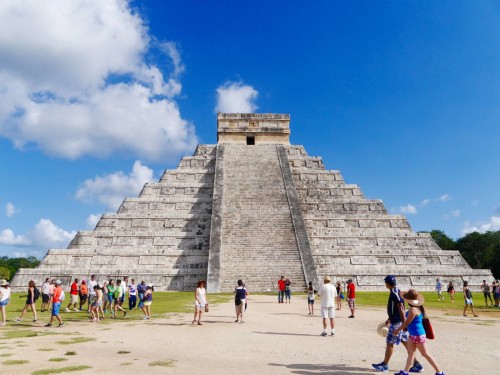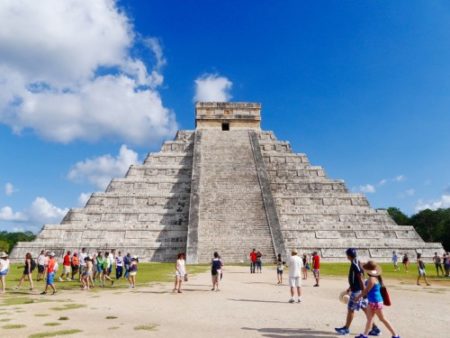Many people have supposed that the ongoing cartel violence in Mexico would hurt tourism, and without doubt it has scared some potential tourists away. Nevertheless, so many foreigners chose to visit Mexico in calendar year 2015, that Mexico had an all-time high of 32 million foreign tourists visiting the country.
Tourism is a great industry for Mexico, as there is so much to see there. In fact, there is something for everyone, it’s relatively inexpensive, and the country has a good tourist infrastructure.
The 32 million report was announced by Enrique de la Madrid, Mexican Tourism Secretary. That’s a record for Mexico, and it puts the country in the world’s top ten tourist destinations.
It’s also an increase of 10 million over 10 years ago, as in 2005 there were 22 million foreign tourists who visited Mexico.
Tourism is an important source of revenue for Mexico, so this is positive economic news.

Crowds of tourists continue to grow at famous sites like Yucatan’s Chichen Itza. (PHOTO: thetravellista.net)
At a press conference, the Tourism Secretary reported that tourism in Mexico has a faster growth than the Mexican economy in general, now accounting for 8.5% of the country’s gross domestic product.
Said Tourism Secretary De la Madrid: “Between 2013 and 2015, international visitors spent $43.5 million a day in Mexico.”
Tourism translates into job creation. Over the past decade, it’s estimated that the tourism industry has created 800,000 jobs directly, and 1.2 million jobs indirectly.
Looking at Mexican tourism by cities, the number one city visited by foreign tourists in 2015 was the capital, Mexico City. That’s not surprising, as there is much to see there. (For some articles I have written about Mexico City, with photographs, click here, here, here and here.)
The #2 Mexican destination in 2015 was Cancun, that glittering strand on the sand, located on a 7-shaped barrier island off the east coast of the Yucatan Peninsula.
Interestingly, the #3 Mexican tourist destination in 2015 was none other than Acapulco, on the Pacific Coast. Why is that interesting? Because Acapulco was also Mexico’s most murderous city of 2015. (See Five Mexican (and Four U.S.) Cities on World’s Most Murderous List.)
With a homicide rate of 104.73 homicides per 100,000 inhabitants, Acapulco was the most murderous city in Mexico and the 4th most murderous city in the world in 2015.
Not only that, but Acapulco is in the state of Guerrero. In 2015, that state had the highest murder rate of any state in Mexico, with 51.12 homicides per 100,000 inhabitants. (See Looking at Mexico’s Latest Homicide Stats and those of others in the Americas.)
And yet Acapulco was Mexico’s third-biggest tourist destination! Isn’t that something?
All in all, the country has a wide variety of tourist attractions, notwithstanding other potential undeveloped tourist areas and attractions.
Mexico has a great variety of scenery. It’s not just the beaches, but also the mountains, deserts, jungles, rivers, lakes and even snow-capped volcanoes. Hiking, boating, hunting and fishing, mountain climbing, and extreme sports can all be practiced.
There are numerous archaeological attractions. Visitors to the Yucatan peninsula can visit Chichen Itza, Coba and Tulum, among other sites. The Teotihuacan complex near Mexico City is quite impressive to visit. In Mexico City, tourists can spend time at the world-famous anthropology museum, where artifacts from various pre-Hispanic cultures are exhibited. Downtown one can see the Templo Mayor museum, in which most of the artifacts on exhibit were excavated onsite.
Spanish colonial architecture in Mexico includes many jewels. The Spaniards constructed beautiful cities such as Queretaro, Guanajuato and Zacatecas. The downtowns of these cities are still well preserved and look as they did centuries ago, making tourists feel as if they are walking the streets of old Spain.
All over the country you can visit interesting museums and colonial churches whose art and architecture qualify them as museums themselves.
Mexico possesses a great variety of regional cultural attractions – traditional cuisine, costume and customs, including seasonal observances.
If tourism is managed properly, not only does it help the economy but it also encourages local communities and residents to preserve the environment and take care of historical and cultural sites. If people have a vested economic interest in such attractions they may take better care of them. After all, if you let things deteriorate you’re losing money.
Hopefully, Mexico’s high tourism dividends can continue and the security situation will improve. That would be a positive development for the entire Mexican society.
By Allan Wall for TYT
——————————
Allan Wall, an educator, resided in Mexico for many years. His website is located at http://www.allanwall.info.



